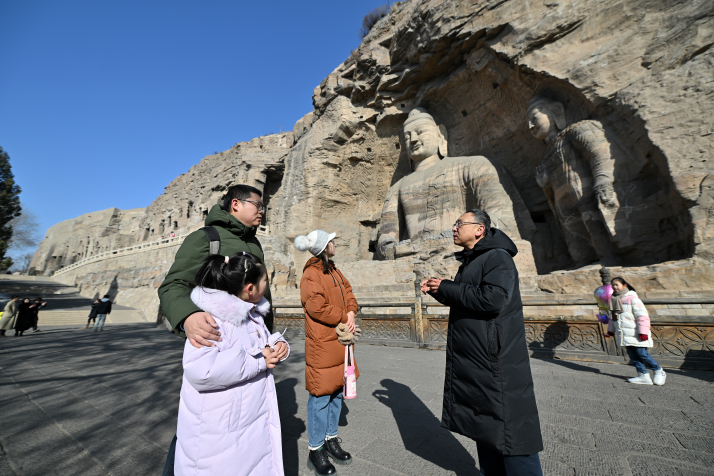| Lifestyle |
| Timeless tapestry | |
|
|
 Visitors at the Yungang Grottoes in Datong, Shanxi Province, on February 25. The grottoes are a microcosm of Buddhist cave art from fifth- and sixth-century China (XINHUA)
In the annals of history, China stands as a venerable testament to the enduring spirit of civilization, a cradle that has nurtured the growth of diverse cultures for over 5,000 years. Beyond being a hub for trade, this ancient land has been a melting pot of ideas, where the ebb and flow of cultural exchange have woven a rich tapestry that continues to shape the nation's identity. At the heart of China's historical legacy lies a remarkable openness to embrace and assimilate new thoughts. The echoes of this trait resonate through time, manifesting in the acceptance and integration of Buddhism and Islam into the Chinese societal fabric. Buddhism, originating in ancient India, found its way to China during the Han Dynasty (206 B.C.- A.D. 220). The tranquility of Buddhist principles harmonized seamlessly with traditional Chinese practices, resulting in a unique blend that not only shaped religious beliefs but also left an indelible mark on art, philosophy and daily life. Islam, too, found a hospitable home in China through the Silk Road, bringing with it a rich heritage of traditions and cultural exchange. The spread of Islam in China dates back to the seventh century, and its assimilation into Chinese society was marked by a respectful coexistence of Islamic principles with local customs. Mosques became architectural wonders, embodying the fusion of Islamic and Chinese artistic styles.
The Niujie Mosque in Beijing (MAZHAR ALAM) This profound openness, extending beyond religious realms, laid the foundation for China's ability to absorb and adapt to new ideas—a quality that has been a driving force in the nation's economic and technological development. The very essence of China's historical narrative is continuous learning, innovation, and progress spurred by an unwavering willingness to engage with the world. The Belt and Road Initiative (BRI), a monumental initiative for connectivity, puts China's enduring philosophy of peaceful existence into practice. The BRI not only seeks to enhance economic cooperation but also serves as a bridge for cultural exchange, echoing the historical spirit of the Silk Road. As the BRI unfolds, it rekindles the ancient Silk Road's ethos of interconnectedness, fostering mutual understanding and cooperation. The initiative spans continents, linking nations through infrastructure projects, trade agreements and cultural exchanges, providing a platform for shared development and prosperity. In contrast to the legacies of colonizing Western nations, China's approach is rooted in collaboration, shared benefits and mutual development. The BRI reflects a commitment to building bridges—both literal and metaphorical—forging connections that transcend borders and foster a shared destiny for all involved. China's idea of a shared future is not merely a diplomatic slogan; it is an echo of its historical journey—a journey marked by openness, inclusivity and a profound understanding that true progress stems from collaboration and mutual respect. China envisions a world where nations work hand in hand toward common goals, promoting inclusive development, environmental sustainability and social harmony. The Chinese concept of a shared future is not confined to economic ties but extends to a shared responsibility for global challenges, fostering a sense of interconnected destinies. In a world often marred by divisions, China's narrative stands as a beacon, reminding us that embracing diversity, learning from others and working toward shared goals can lead to a more prosperous and harmonious future for all. As we reflect on China's 5,000-year odyssey, we find not just a chronicle of the past but a roadmap for the future. It is a narrative that beckons us to embrace openness, celebrate diversity, and forge a world where the threads of shared destinies intertwine to weave a tapestry of enduring peace and prosperity. The author is a Pakistani anthropologist living in Beijing Copyedited by G.P. Wilson Comments to yanwei@cicgamericas.com |
|
||||||||||||||||||||||||||||
|
